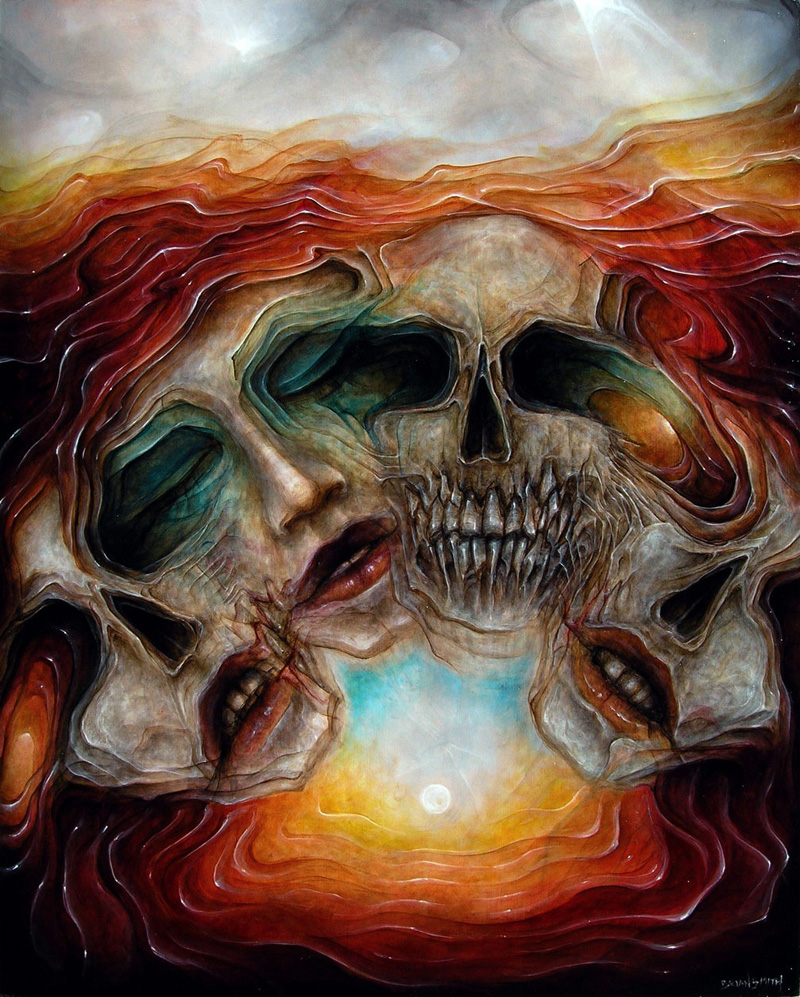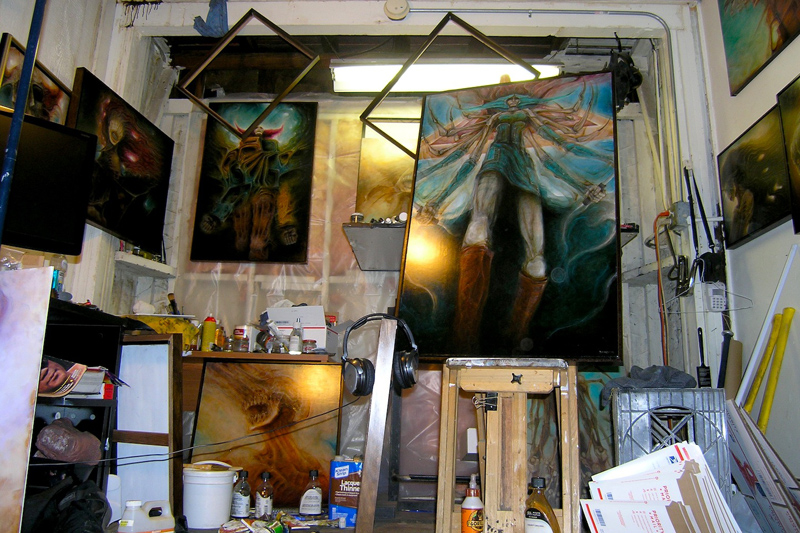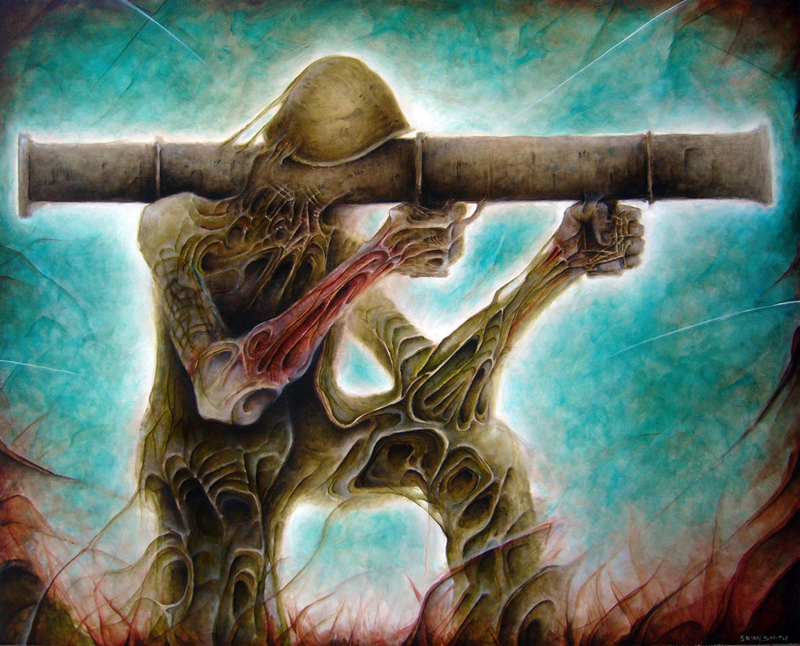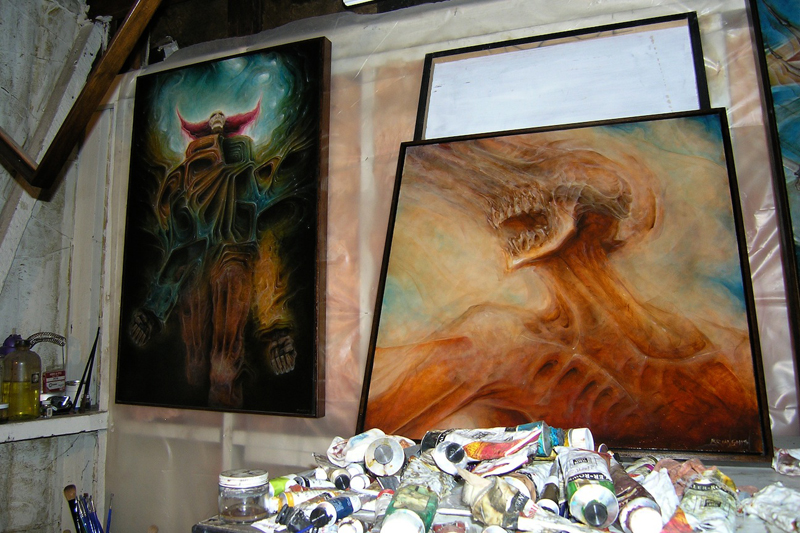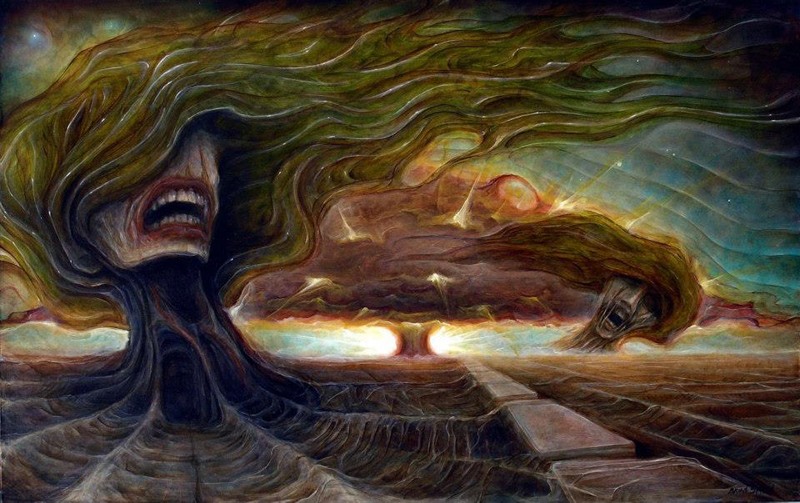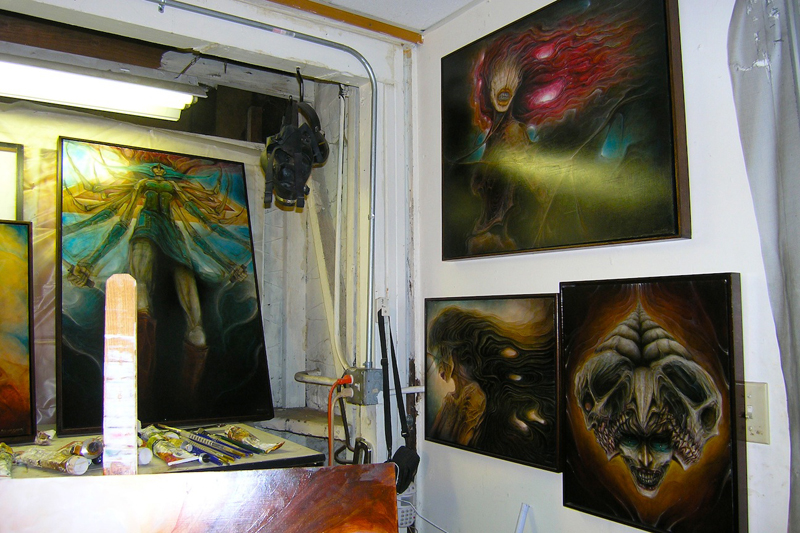As we countdown to Baby Tattooville, we have a couple more interviews from participating artists to share with you. Los Angeles based painter Brian Smith recently spent some time talking to AM about his dark, flowing art work, what it was like not making art for a decade and why he is excited to be a part of this year’s Baby Tattooville. See below for the conversation, some studio shots, work in progress shots and a few examples of Brian’s work.
Arrested Motion (AM): You famously took a ten-year hiatus from making art. Can you tell me how it felt when you decided to get back to it? Is there a story / event that was the tipping point in making the decision to return to art?
Brian Smith: I didn’t really know what I was doing or getting into, so I was kind of excited and unsure about the whole thing. I knew I could make some good art if I could find the time for it, but I’d never really painted before, so figuring that out and how to make a living doing it were two big question marks.
The internet was definitely one tipping point. This was back in ’04/05 and that’s around the time everyone had computers, and 10 years worth of content was online. So I knew it’d be easy to look up tons of art, and that once I got some work together I could start posting pics and people would actually see ’em. Just 5 or 10 years earlier things were very different.
AM: Your paintings have a flowing style. Do you see them before you start or do they evolve as you create them (does your work ever surprise /scare you)? .
Brian Smith: I’m always thinking about what I’d like to paint but I can never get a very clear image of it in my head. I wish I could. It helps me to just have a general idea, and then start working and sketching in the paint and see what happens. Faces and figures and things like that start to appear when you’re looking for ’em. You can train your eye to get good at that kind of thing.
The paintings change a lot from start to finish, so they’re always kind of a surprise, but never scary to me or anything like that. I’m more interested in the things that scare the scary things. The things you don’t see in a painting.
AM: What’s your proudest moment as an artist? Can you take us through experience?
Brian Smith: I feel good about some of my better paintings. There are 10 or 12 that stand out for me. A few years ago I finished a big piece that I’d been working on for about a month. I framed it, hung it up on the wall, took a good look and felt like I’d really nailed it. Something like that is tough to beat. I still have that piece and never really get tired of looking at it.
AM: Can you tell me about a typical day for you (I would love to hear if you are up early, or stay up late, what your studio is like, coffee shops, art supply stores, etc)?
Brian Smith: I live and work out of a small space with only a bed, a computer, and an easel. It’s great for what I do because it’s private and quiet at night and there’s just nothing else to do besides paint, sleep or go online. I get up early and put off painting for as long as I can, but once I get going I try to work until around midnight. I work on a rotation of 2 or 3 pieces, and I have an on-and-off kind of routine where I’ll paint and take breaks in 20-30 minute shifts, back-and-forth, back-and-forth. It helps me to try to focus in short bursts and not just sit and stare at a painting all day. There are just too many distractions out there anymore.
AM: Can you tell me how creating your art feels, ie is it therapeutic, do you have to suffer for art, draining, energizing, uplifting, scary, fun? How do you know when a piece is finished, and how does it feel when you realize that a particular work is completed?
Brian Smith: At times, it’s all of those things. Maddening and therapeutic. I do kind of suffer through the process because painting is still new to me. It’s great when you’re in a zone and focused and things are working and you’re finishing good paintings. It can be kind of a nightmare when you’re not.
I give up on a lot of paintings, so I feel pretty good when I manage to finish one. It’s always a relief to be done with one and to be able to move on to the next. Sometimes you just know they’re finished because they look and feel right, … nothing looks out of place or catches your eye unless you want it to. Other times, you can sense that you’ve come up short and know that something’s missing. I hang on to those pieces because sometimes it can take 6 months to figure out that one little thing.
AM: Have you ever had an encounter with another artist that you found especially profound, or had a lasting effect on you?
Brian Smith: Definitely. I’ve seen Michael Hussar paint a few times. He’s really good so he makes it look easy. You can learn a lot watching someone that’s that good at what they do.
AM: Is this your first time at Baby Tattooville? Are there any artists you are excited to meet that will be at Baby Tattooville?
Brian Smith: I was there 3 or 4 years ago, but this is my first time as a guest artist. I’m looking forward to meeting all of them. I’ve seen their work and know they’re great artists so I’ll bug ’em for painting tips.
AM: Words like “dark, weird and psychedelic” come up a lot when describing your work. Would you say that your subject matter is more about internal human pain and emotions, or is it more supernatural in nature?
BS: It’s all very human and personal to me. Maybe in the same way a dream is real but not real. It’s all real in the sense that you can make conscious decisions in your dreams, and they can have an affect on you when you wake up.
Sometimes, there’s more of a conceptual kind of thing happening, maybe someone going through a change or transformation, coming back to life or dying. I like those kinds of transitional elements in a painting. Other times, I see things like screaming, crying, animal, tree, brunette, redhead, etc.
AM: In other interviews you have mentioned loving painting your whole life. Can you tell me how you honed your signature style, and if there were events that shaped it?
Brian Smith: I’m always trying to paint things that are new to me and don’t look a whole lot like anything I’ve seen before. Sometimes, it happens sometimes it doesn’t, but that’s the idea, so I experiment and look for new ways to do things. An artwork can be made up of thousands of little decisions and if you make a lot of paintings, you have plenty of time to pick and chose what really works for you and what doesn’t.
As far as events, I’d have to say the ’70s. Back then, you were kind of surrounded by things that were interesting and colorful, weird and different. Even things like ads and billboards and commercials weren’t so bad because they had a great graphic quality and design element. And things like bad music and bad movies were still pretty good. It’s not like that anymore. I don’t think there’s as much of a focus on craftsmanship and ideas and things like that. Maybe I’m wrong and it’s just a lot of what we see is what’s popular and force-fed to us. Anyway, I was just kid back then but I think all of that made a strong impression on me and anybody that lived through those years.
AM: Can you tell me about being an artist in Los Angeles (do you go to a lot of the shows, enjoy the good weather, meet a lot of other artists)?
BS: LA’s hot, crowded and expensive, but it’s also kind of at the center of a dark, weird art movement, with tons of great artists and galleries and people that like this kind of thing. It extends out all over the world through the internet, so this is a great place to be and a good time to be a part of what’s going on. It’s fun to be able to follow artists that I like and see their work and go to their shows. I’ve been lucky enough to meet some of ’em and make some good friends out here.
AM: Any projects coming up you would like to talk about?
BS: After Baby Tattooville, I’ll be in a couple’a group shows at Copro Gallery in Los Angeles. One is Chet Zar’s Conjoined sculpture show and the other is curated by collector Cris Velasco. These guys know good art so they’ll be great shows.



